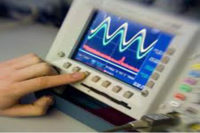Repeatability and reliability are critical to a sensor's overall performance on an automated processing line. One of the most common types of sensors used for object detection, diffuse photoelectric sensors perform well in a wide range of industrial processing applications. However, these sensors can experience problems with some target or background materials.
The simplest diffuse photoelectric sensors use the target object as the reflective surface for object detection. Detection occurs when a beam of infrared, visible red or laser light emitted from the sensor is deflected off the target material in all directions and detected by the receiver.
The accuracy of these sensors is often at the mercy of the surface properties of the target and background materials. A nonreflective target, such as a matte or dull black material, is difficult for diffuse photoelectric sensors to detect, because it reflects much less light than a brightly colored or white target. Similarly, if the target is presented against a light-colored or reflective background, the sensor can be falsely triggered by light reflected from the background material rather than the target object.
To overcome these challenges, a variety of technologies have been developed to allow the sensors to see an object while ignoring background materials.
Operating Principles for Photoelectrics
To ensure repeatability and reliability, photoelectric sensors are available with three different types of operating principles: fixed-field sensing, adjustable-field sensing and background suppression through triangulation. In the simplest terms, these sensors are focused on a specific point in the foreground, ignoring anything beyond that point.
Standard fixed-field sensors operate optimally at their preset "sweet spot," the distance at which the foreground receiver will detect the target. As a result, these sensors must be mounted within a certain fixed distance of the target. In fixed-field technology, when the emitter sends out a beam of light, two receivers sense the light on its return. The short-range receiver is focused on the target object's location. The long-range receiver is focused on the background. If the long-range receiver detects a higher intensity of reflected light than the short-range receiver, the output will not turn on. If the short-range receiver detects a higher intensity of reflected light than the long-range receiver, an output occurs and the object is detected.
Adjustable-field sensors operate under the same principle as fixed-field sensors, but the sensitivity of the receivers can be electrically adjusted using a potentiometer. By adjusting the level of light needed to trigger an output, the sensor's range and sensitivity can be altered to fit the application.
However, with both fixed- and adjustable-field diffuse photoelectric sensors, reliability is still a concern. High-gloss target materials and reflective or light-colored objects outside the sensing area can deflect enough light back to the receivers to trigger a false output.
Sensors that use the third operating principle, background suppression by triangulation, also emit a beam of light that is deflected back to the sensor. Unlike fixed- and adjustable-field sensors, which rely on the intensity of the light reflected back to them, background suppression sensors rely completely on the angle at which the beam of light returns.
Like fixed- and adjustable-field sensors, background suppression sensors feature short- and long-range receivers in fixed positions. In addition, background suppression sensors have a pair of lenses that are mechanically adjusted to precisely focus the reflected beam to the appropriate receiver, changing the angle of the light received. The long-range receiver is focused through the lens on the background. Deflected light returning along that focal plane will not trigger an output. The short-range receiver is focused, through a second lens, on the target. Any deflected light returning along that focal plane will trigger an output-an object will be detected.
This configuration allows for an extremely steep cutoff between target and background, sometimes smaller than 0.1 millimeter. This is perfect for applications where there is little distance between the target and background. For example, when detecting labels on a roll, background suppression can ignore the roll's backing and detect the label itself. Laser sensors with background suppression can even count the columns on a penny by suppressing the flat of the background. The etched columns offer a large enough variation to trigger an output.
Because reflectivity and color affect the intensity of reflected light but not the angles of refraction, sensors with background suppression technology are highly stable and reliable in applications where reflective backgrounds or large variations in target color are a concern. In an extreme example, a triangulation sensor will repeatably detect a brand new dime lying on a polished mirror.
Choosing the Right Principle
For applications where backgrounds are not within sensing range and target color is consistent, a standard diffuse sensor is completely sufficient for object detection. These sensors are also quite effective for detecting large objects.
Similarly, if a background within the sensing range is not particularly reflective and the color and reflectivity of the target will remain relatively constant, a fixed-field or adjustable-field sensor will likely provide trouble-free performance. These sensors are also appropriate for smaller targets than standard diffuse sensors.
When reliable sensing is challenging due to shiny backgrounds and targets, shifting colors and reflectivity, background suppression by triangulation is the most repeatable and reliable solution. These sensors, especially laser varieties, are very effective for detecting ultra-small targets. The precisely focused, finely collimated beam allows them to detect extremely small items.
